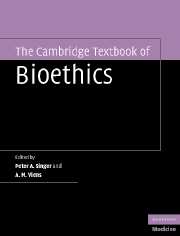Book contents
- Frontmatter
- Contents
- List of contributors
- Acknowledgements
- 1 Introduction
- Section I Information problems
- Section II End of life care
- Section III Pregnant women and children
- Section IV Genetics and biotechnology
- Section V Research ethics
- Section VI Health systems and institutions
- Section VII Using clinical ethics to make an impact in healthcare
- Section VIII Global health ethics
- Section IX Religious and cultural perspectives in bioethics
- Introduction
- 47 Aboriginal bioethics
- 48 Buddhist bioethics
- 49 Chinese bioethics
- 50 Hindu and Sikh bioethics
- 51 Islamic bioethics
- 52 Jehovah's Witness bioethics
- 53 Jewish bioethics
- 54 Protestant bioethics
- 55 Roman Catholic bioethics
- Section X Specialty bioethics
- Index
- References
55 - Roman Catholic bioethics
Published online by Cambridge University Press: 30 October 2009
- Frontmatter
- Contents
- List of contributors
- Acknowledgements
- 1 Introduction
- Section I Information problems
- Section II End of life care
- Section III Pregnant women and children
- Section IV Genetics and biotechnology
- Section V Research ethics
- Section VI Health systems and institutions
- Section VII Using clinical ethics to make an impact in healthcare
- Section VIII Global health ethics
- Section IX Religious and cultural perspectives in bioethics
- Introduction
- 47 Aboriginal bioethics
- 48 Buddhist bioethics
- 49 Chinese bioethics
- 50 Hindu and Sikh bioethics
- 51 Islamic bioethics
- 52 Jehovah's Witness bioethics
- 53 Jewish bioethics
- 54 Protestant bioethics
- 55 Roman Catholic bioethics
- Section X Specialty bioethics
- Index
- References
Summary
Mrs. I is 25 years old and is about 10 weeks' pregnant. She has tuberculous meningitis. Her disease was in an advanced stage when she was admitted to hospital and underwent surgery to relieve the pressure on her brain. She is now clinically brain dead. Her husband – like the patient, a devout Catholic – requests that her body be maintained on life support in the intensive care unit to save her fetus. Other family members concur that she is “pro-life” and would want to carry the fetus to term if possible. (Although far from typical, this is an actual case. All of the details included in this discussion are taken from the public record [Fox 1999; Priest and Slaughter 1999]).
What is Catholic bioethics?
There is a long tradition of bioethical reasoning within the Roman Catholic faith, a tradition that extends from Augustine's writings on suicide in the early Middle Ages to recent papal teachings on euthanasia and reproductive technologies. Roman Catholic bioethics (which we refer to in this article simply as Catholic bioethics) comprises a complex set of positions that have their origins in scripture, the writings of the doctors of the Church, papal encyclicals, and reflections by contemporary Catholic theologians and philosophers. Informed by scriptural exegesis and by philosophical argument, Catholic bioethics is rooted in both faith and in reason.
- Type
- Chapter
- Information
- The Cambridge Textbook of Bioethics , pp. 436 - 442Publisher: Cambridge University PressPrint publication year: 2008
References
- 1
- Cited by



